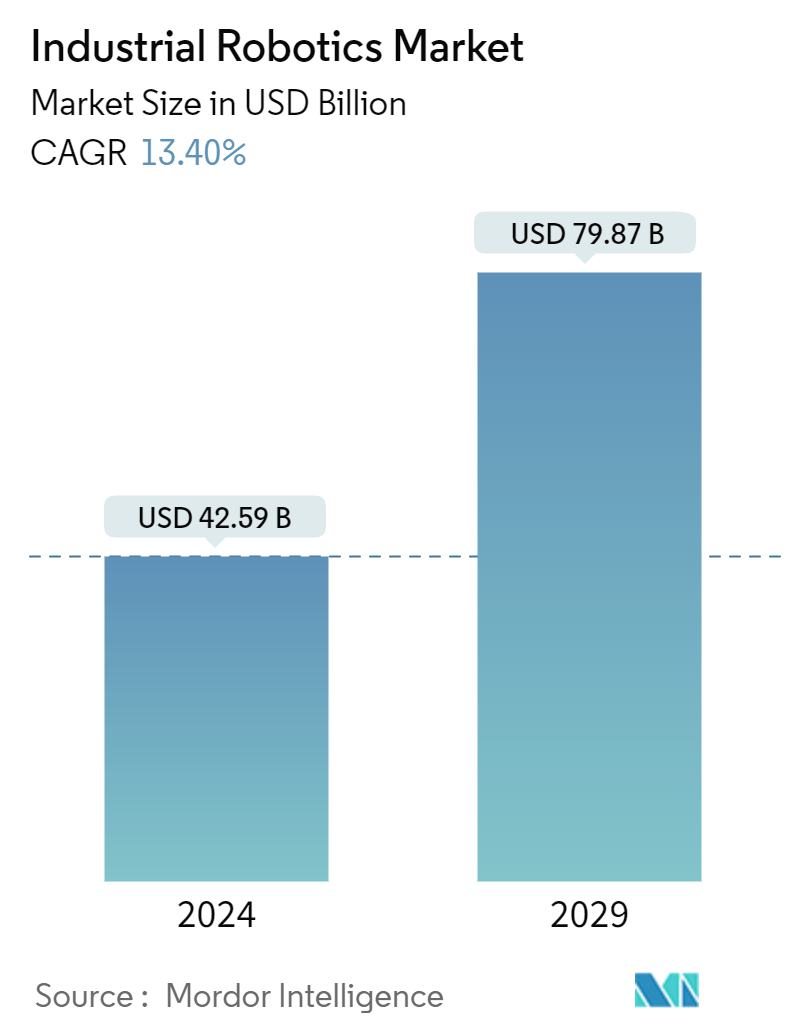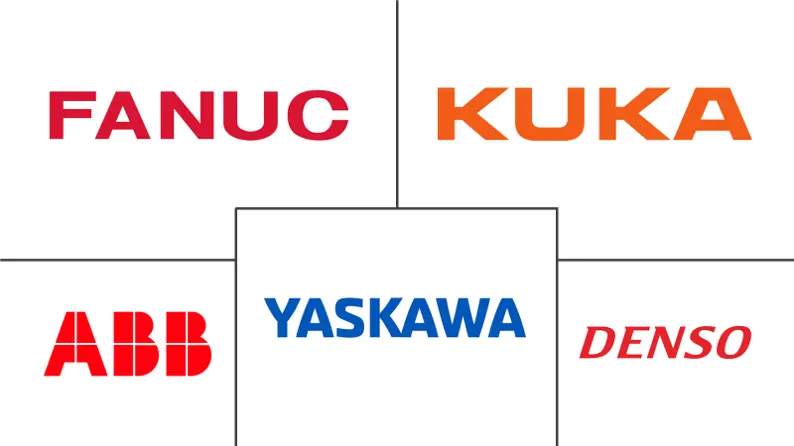Market Size of Industrial Robotics Industry

| Study Period | 2019 - 2029 |
| Market Size (2024) | USD 42.59 Billion |
| Market Size (2029) | USD 79.87 Billion |
| CAGR (2024 - 2029) | 13.40 % |
| Fastest Growing Market | Asia Pacific |
| Largest Market | North America |
| Market Concentration | Low |
Major Players
*Disclaimer: Major Players sorted in no particular order |
Industrial Robotics Market Analysis
The Industrial Robotics Market size is estimated at USD 42.59 billion in 2024, and is expected to reach USD 79.87 billion by 2029, growing at a CAGR of 13.40% during the forecast period (2024-2029).
- Industrial robots play a crucial role in manufacturing industrial automation, with many core operations in industries being managed by robots. With economic growth across regions, e-commerce, electronics, and the automotive industry, among others, have increased.
- Rising penetration of the IoT and investments in robotics across regions have been major contributors to the market's growth. For instance, the 'Made in China 2025' announcement aimed to broadly upgrade the Chinese industry by moving toward quality-focused and innovation-driven manufacturing.
- Industry 4.0, the newest industrial revolution, has fueled the development of new technologies, like collaborative robots, AI-enabled robots, etc., and has enabled industries to use robots to streamline many processes, increase efficiency, and eliminate errors. Increased workplace safety and improved production capabilities have further driven industries to invest in robotic systems.
- Owing to collaborative robots, which are estimated to account for 34% of the total robot sales in 2025 (according to the International Federation of Robots (IFR), the penetration of industrial robots is expected to rise across industries, such as plastics, food and consumer goods, semiconductors and electronics, life sciences, and pharmaceuticals. Another notable factory automation is expected at Apple's factories through Foxconn's robots. Semiconductor industry IC foundries have been among the adopters that have impacted the current market demands.
- Some of the major factors driving the market include rising demand for high-quality products (which need proper end-to-end visibility in the manufacturing process), the need for energy conservation, and rising focus on workplace safety. Incremental advancements in technology, coupled with a sustained increase in the development of manufacturing facilities, are also expected to drive this market, for instance, According to the Association for Advancing Automation (A3), which monitors industrial robot sales in North America. Companies ordered 44,196 robots in 2022, 11% more than in 2021.
Industrial Robotics Industry Segmentation
An industrial robot is a robot system used for manufacturing. Industrial robots are automated, programmable, and capable of movement on three or more axis. Industrial robots are used in multiple industries and applications. The elimination of labor-intensive activities is driving the Industrial robotics market.
The industrial robotics market is segmented by type of robot (articulated robots, linear robots, cylindrical robots, parallel robots, SCARA Robots), end-user industry (automotive, chemical, and manufacturing, construction, electrical and electronics, food and beverage, machinery and metal, pharmaceutical), and Geography Europe (United Kingdom, Germany, France, rest of Europe), Asia Pacific (Japan, China, India, South Korea, and Rest of Asia Pacific), Latin America, Middle East and Africa. The market sizes and forecasts are provided in terms of value (USD) for all the above segments.
| By Type of Robot | |
| Articulated Robots | |
| Linear Robots | |
| Cylindrical Robots | |
| Parallel Robots | |
| SCARA Robots | |
| Other Types of Robot |
| By End-user Industry | |
| Automotive | |
| Chemical and Manufacturing | |
| Construction | |
| Electrical and Electronics | |
| Food and Beverage | |
| Machinery and Metal | |
| Pharmaceutical | |
| Other End-user Industries (Rubber, Optics) |
| By Geography*** | ||||||
| ||||||
| ||||||
| ||||||
| Australia and New Zealand | ||||||
| Latin America | ||||||
| Middle East and Africa |
Industrial Robotics Market Size Summary
The industrial robotics market is poised for significant expansion, driven by the increasing integration of robots in manufacturing processes across various sectors such as e-commerce, electronics, and automotive industries. The adoption of Industry 4.0 principles has accelerated the development of advanced technologies, including collaborative and AI-enabled robots, which are enhancing operational efficiency and safety in manufacturing environments. The rise of the Internet of Things (IoT) and substantial investments in robotics are further propelling market growth. Collaborative robots, in particular, are expected to see substantial penetration, impacting industries like plastics, food and consumer goods, semiconductors, and pharmaceuticals. The automotive sector remains a major user of industrial robots, with ongoing advancements in robotics technology facilitating greater automation and efficiency in manufacturing processes.
Government initiatives and strategic partnerships are also playing a crucial role in fostering the growth of the industrial robotics market. Programs like the National Robotics Initiative in the United States aim to bolster domestic robot development and research. Collaborations between companies, such as the joint venture between Huayu Automotive Systems Co. and ABB Group, are driving innovation and smart manufacturing solutions. The market is characterized by high competitive rivalry and fragmentation, with major players like ABB and Yaskawa leading the charge. Recent product launches, such as ABB's modular large robots and Mobile Industrial Robots' autonomous pallet jack, highlight the ongoing innovation and expansion within the industry. These developments underscore the market's potential for continued growth and the increasing importance of robotics in modern manufacturing.
Industrial Robotics Market Size - Table of Contents
-
1. MARKET DYNAMICS
-
1.1 Market Drivers
-
1.1.1 Increased Emphasis on Workplace Safety
-
1.1.2 Emerging Technologies in Industrial Robots
-
-
1.2 Market Restraints
-
1.2.1 Lack of Skilled Workforce
-
-
-
2. MARKET SEGMENTATION
-
2.1 By Type of Robot
-
2.1.1 Articulated Robots
-
2.1.2 Linear Robots
-
2.1.3 Cylindrical Robots
-
2.1.4 Parallel Robots
-
2.1.5 SCARA Robots
-
2.1.6 Other Types of Robot
-
-
2.2 By End-user Industry
-
2.2.1 Automotive
-
2.2.2 Chemical and Manufacturing
-
2.2.3 Construction
-
2.2.4 Electrical and Electronics
-
2.2.5 Food and Beverage
-
2.2.6 Machinery and Metal
-
2.2.7 Pharmaceutical
-
2.2.8 Other End-user Industries (Rubber, Optics)
-
-
2.3 By Geography***
-
2.3.1 North America
-
2.3.1.1 United States
-
2.3.1.2 Canada
-
-
2.3.2 Europe
-
2.3.2.1 United Kingdom
-
2.3.2.2 France
-
2.3.2.3 Germany
-
-
2.3.3 Asia
-
2.3.3.1 Japan
-
2.3.3.2 China
-
2.3.3.3 India
-
2.3.3.4 South Korea
-
-
2.3.4 Australia and New Zealand
-
2.3.5 Latin America
-
2.3.6 Middle East and Africa
-
-
Industrial Robotics Market Size FAQs
How big is the Industrial Robotics Market?
The Industrial Robotics Market size is expected to reach USD 42.59 billion in 2024 and grow at a CAGR of 13.40% to reach USD 79.87 billion by 2029.
What is the current Industrial Robotics Market size?
In 2024, the Industrial Robotics Market size is expected to reach USD 42.59 billion.

